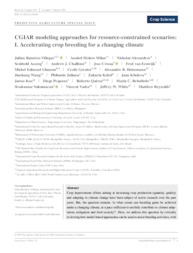CGIAR modeling approaches for resource-constrained scenarios: I. Accelerating crop breeding for a changing climate.
CGIAR modeling approaches for resource-constrained scenarios: I. Accelerating crop breeding for a changing climate.
Author(s): RAMIREZ-VILLEGAS, J.; MOLERO MILAN, A.; ALEXANDROV, N.; ASSENG, S.; CHALLINOR, A. J.; CROSSA, J.; VAN EEUWIJK, F.; GHANEM, M. E.; GRENIER, C.; HEINEMANN, A. B.; WANG, J.; JULIANA, P.; KEHEL, Z.; KHOLOVA, J; KOO, J.; PEQUENO, D.; QUIROZ, R.; REBOLLEDO, M. C.; SUKUMARAN, S.; VADEZ, V.; WHITE, J. W.; REYNOLDS, M.
Summary: Crop improvement efforts aiming at increasing crop production (quantity, quality) and adapting to climate change have been subject of active research over the past years. But, the question remains 'to what extent can breeding gains be achieved under a changing climate, at a pace sufficient to usefully contribute to climate adaptation, mitigation and food security?'. Here, we address this question by critically reviewing how model-based approaches can be used to assist breeding activities, with particular focus on all CGIAR (formerly the Consultative Group on International Agricultural Research but now known simply as CGIAR) breeding programs. Crop modeling can underpin breeding efforts in many different ways, including assessing genotypic adaptability and stability, characterizing and identifying target breeding environments, identifying tradeoffs among traits for such environments, and making predictions of the likely breeding value of the genotypes. Crop modeling science within the CGIAR has contributed to all of these. However, much progress remains to be done if modeling is to effectively contribute to more targeted and impactful breeding programs under changing climates. In a period in which CGIAR breeding programs are undergoing a major modernization process, crop modelers will need to be part of crop improvement teams, with a common understanding of breeding pipelines and model capabilities and limitations, and common data standards and protocols, to ensure they follow and deliver according to clearly defined breeding products. This will, in turn, enable more rapid and better-targeted crop modeling activities, thus directly contributing to accelerated and more impactful breeding efforts.
Publication year: 2020
Types of publication: Journal article
Unit: Embrapa Rice & Beans
Observation
Some of Embrapa's publications are published as ePub files. To read them, use or download one of the following free software options to your computer or mobile device. Android: Google Play Books; IOS: iBooks; Windows and Linux: Calibre.
Access other publications
Access the Agricultural Research Database (BDPA) to consult Embrapa's full library collection and records.
Visit Embrapa Bookstore to purchase books and other publications sold by Embrapa.

